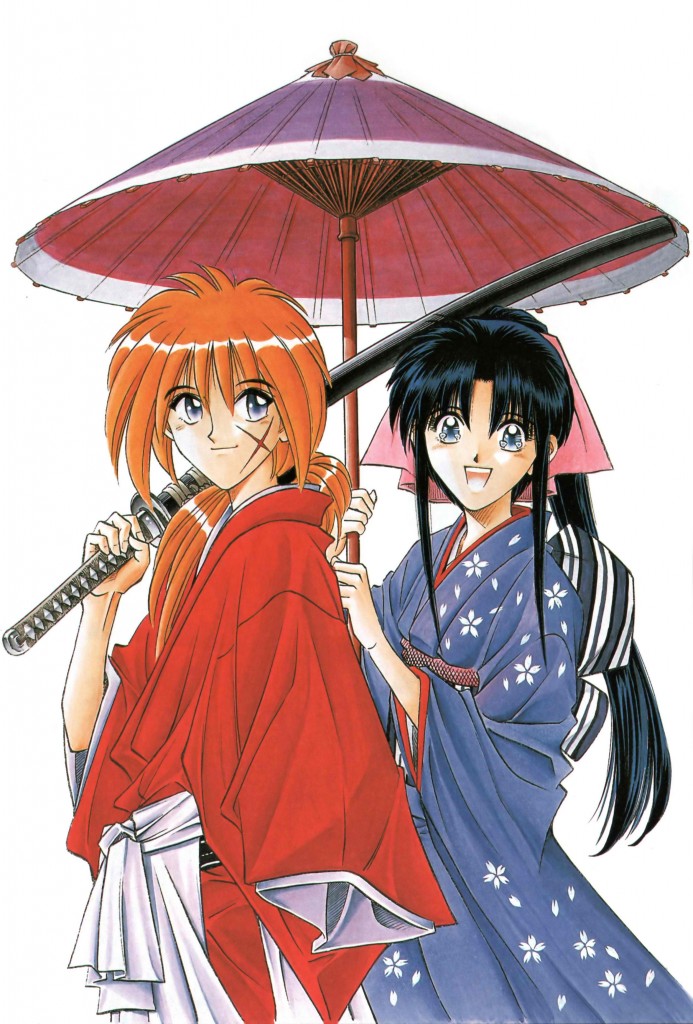
(Be sure to check out yesterday’s post).
Rurouni Kenshin is a popular manga (Japanese comic book) written and drawn by Nobuhiro Watskui in the mid 1990s. It spawned two equally popular anime TV series, a theatrical anime film, two animated OVA films, and most recently a live-action film produced by Warner Bros. (which has yet to receive a wide release in America, unfortunately).
(Note: This blog will focus on the original manga. The adaptations are different. For one thing, the manga has a happier ending).
(SPOILER WARNING!)
Set in 19th century Japan 10 years after the Meiji Revolution, the titular character, Kenshin Himura, is a young swordsman with cross-shaped scar on his face who has been wandering Japan (rurouni is the Japanese word for “wanderer”) since the war’s end, righting any wrongs he finds as atonement for the atrocities he committed. He has sworn never to kill again and carries a sakabatou (reverse-blade sword) that allows him to fight without killing anyone. He goes to Tokyo and meets Kaoru Kamiya, a young woman running her deceased father’s kendo dojo, and decides to stop wandering. As time passes, he meets several other “rough” characters he helps reform and battles several powerful villains.
A subtitle for the series is Meiji Swordsman Romantic Story, which describes it very well. The series’ theme is redemption, but its heart is the romance between Kenshin and Kaoru. In true Japanese fashion, it is an understated and subtle romance—at first. Kaoru begins to fall for Kenshin after a few adventures, but Kenshin never seems to reciprocate. He treats her with respect as a friend, always calling her “Kaoru-dono” (a formal Japanese honorific title usually translated as “Ms. Kaoru”). Several times Kaoru has to pull Kenshin from the brink when he slips into the violent ways of Battousai, his dark and violent self from the war. She gives him a home when he was wanderer.
Until one night when, surrounded by fireflies, Kenshin comes to her—and only her—and says he must leave to go fight a deadly enemy in Kyoto. She is the only one he says goodbye to. There’s no farewell kiss, no sappy sweet nothings. Kenshin simply thanks her for everything she’s done for him and hugs her. It’s a powerful scene, one that I’m man enough to admit nearly made me cry when I watched it on the anime. (You can watch it here).
Kaoru at first wallows in her sorrow, but her friends chastise her and say that if she cares about him so much, she should go after him. She does. She catches up to Kenshin before he battles his nemesis. Her love helps strengthen Kenshin in the ensuing battle. But she learns afterward that Kenshin’s body has been so badly battered over the years that another severe injury may kill him.
In the manga’s final storyline (which the anime excludes), Kaoru is captured by Enishi, a psychotic young man, with a grudge against Kenshin. She learns from him that during the war, Kenshin married a woman named Tomoe, who died tragically at his hands. That’s why he was closed off, why he refused to reciprocate Kaoru’s love: he didn’t want to lose someone like that again. Enishi says he is Tomoe’s brother and will avenge his sister’s death.
Kenshin is pushed to his physical, mental, and emotional limits. Enishi fakes Kaoru’s death. When Kenshin finds her purported corpse, he yells her name without adding “-dono” for the first time. Kenshin is overcome with despair, during which he sees Tomoe in his dreams. She is smiling because she says Kenshin has learned to smile. She tells him to save her brother, who is still stuck in the past, and rescue Kaoru, who wants and needs his smile most. Kenshin awakes and goes to confront not only Enishi but the demons from his past. He defeats the young man and spares his life.
Finally, Kenshin and Kaoru get married and have a son named Kenji.
This is a romance full of longsuffering, patience, acceptance, and forgiveness. Kaoru loves Kenshin despite his violent and dark past. Kenshin learns to open up and love again. Kaoru gives Kenshin the wanderer a home. They complement each other perfectly. Kenshin’s calm demeanor is great counterbalance to Kaoru’s feistiness and Kaoru’s goodness pulls Kenshin from his inner darkness.
This also shows that a romance can be subtle. Often love stories are sappy and overdone, but this one is so understated that the reader has to connect the dots. I can’t recall either of them ever saying “I love you” to each other, yet the reader knows they do. It truly is an example of “less is more.”
Their romance blossomed slowly, often in dark times. Both Kenshin and Kaoru made sacrifices for what they thought was the good of the other. It was never easy for them until the end.
I neglected to mention that both the manga and original anime (I haven’t seen the new one yet) are also quite funny. In fact, I’d even go so far as to classify them as romantic comedies at points.
I could go on for hours about their story. This was one of the first romances I truly loved. As fantastical as the series was, their love felt real and authentic. Many romances in mangas/animes tend to go (for lack of a better term) unconsummated: the couple never gets together. It was refreshing to see a happy ending for a change.
NEXT TIME ON “TRUE ROMANCE”: A trip across “the Pond” for a love that spans time and space!
